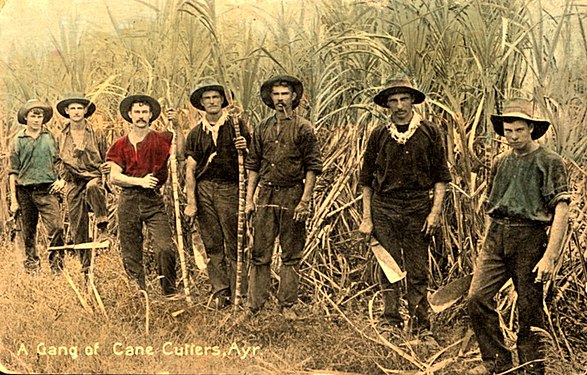
A cane knife is a large hand-wielded cutting tool similar to a machete. Its use is prevalent in the harvesting of sugarcane in dominant cane-growing countries such as Peru, Brazil, Colombia, Australia, South Africa, Ecuador, Cuba, Jamaica, the Philippines and parts of the United States, especially Louisiana and Florida, as well as Hawaii. It is the primary tool used in countries that do not employ mechanical means for harvesting cane.
In the Philippines, particularly in Negros Island, itinerant sugarcane cutters called sacadas employ this blade, which they call an espading. The term is borrowed from the Spanish word espada, meaning "sword", while in Tagalog it is called palang. In the South Pacific, the metal hook of the cane knife was melded with the indigenous serrated warclub, resulting in the hook-bladed weapon used in modern Samoan fire knife dancing.
Design
A typical cane knife is characterized by a hardwood handle, a full tang, a deep blade and a hook at its tip used for picking up the cut cane, although some types do not employ this feature. The blade is usually 1 millimetre (0.039 in) thick, thinner than a machete or bolo, and more than 12 inches (30 cm) long. The thin blade facilitates cutting cane quickly as the harvester slashes the cane at an angle: a thin blade slices through better than a thick blade.
Gallery
-
 Sugar cane knife, 1800s, used by enslaved Africans to cut sugar cane in the Danish West Indies
Sugar cane knife, 1800s, used by enslaved Africans to cut sugar cane in the Danish West Indies
-
 1888 drawing of "Queen Mary" Thomas, one of the leaders of the 1878 Fireburn riot in St. Croix, holding a cane knife and torch
1888 drawing of "Queen Mary" Thomas, one of the leaders of the 1878 Fireburn riot in St. Croix, holding a cane knife and torch
-
 A sugar cane cutter in Cuba during zafra
A sugar cane cutter in Cuba during zafra
-
 Canecutters in Ayr, Australia c.1907
Canecutters in Ayr, Australia c.1907
-
 Female cane cutters in Barbados, 2011
Female cane cutters in Barbados, 2011
-
 A well-used cane knife
A well-used cane knife
-
 Old cane knife in south Louisiana, of the type that was the most common weapon in the 1811 German Coast uprising.
Old cane knife in south Louisiana, of the type that was the most common weapon in the 1811 German Coast uprising.
See also
References
- Hanson, Beth (1996). "Chapter 3 - Tools & Techniques: Chemical-free Weed Controls". Invasive Plants: Weeds of the Global Garden. Brooklyn Botanic Garden. p. 14. ISBN 978-0-945352-95-2. Retrieved 2008-02-08.
This article relating to knives is a stub. You can help Misplaced Pages by expanding it. |